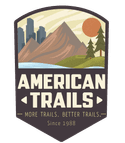Learn how to practice, promote, and share the Trails Safe Passing Plan (TSPP) of Stop! Speak and Stand Back and how this safety action plan can be used on your websites, offered to trail user groups during meetings, delivered to land management teams for public safety announcements and used at trailheads and kiosks.
The Trails Safe Passing Plan (TSPP) STOP! SPEAK and STAND BACK is a safety action plan for ALL trail users on what to do when meeting people with horses on the trails.
The Trails Safe Passing Plan (TSPP) Stop! Speak and Stand Back allows you to safely share the trails and is helpful for all trail users, including horses and dogs. Many trail users may not know what to do when meeting horses on the trails. Anecdotal evidence suggests trail users are not interested in making a passing plan with strangers, or they don’t want to wait until a horseback rider is near enough to communicate instructions.
It is best to know what to do, BEFORE you encounter other trail users. The TSPP sign, the QR Code, the PowerPoint, and PDF of the Trails Safe Passing Plan (TSPP) Stop! Speak and Stand Back have been produced as educational resources for trail users to navigate our trails safely and efficiently. The webinar provides information about yielding on trails, trail communication, and facts about horses to help all trail users and land management teams understand the importance of having a trails safe passing plan in place at trailheads and kiosks.
Trails are Common Ground * and we all have the opportunity to help make the trails enjoyable and safe for everyone. Our goal is to show how learning and performing these actions can inform trail users on what to do when meeting horses on the trail. When a trails safe passing plan is posted, every trail user can discover how to become a safer trail user. When a trail safe passing plan is not posted, many trail users are not comfortable on shared trails. People with horses often choose not to use the trails, due to possible injury risk.
In recreational land use, as stakeholders, we must encourage land management teams and trail groups to participate in inclusive recreation opportunities. We believe that the Trails Safe Passing Plan (TSPP) Stop! Speak and Stand Back and our new TSPP Sign with a QR Code (that can include a local sponsor logo) will be a win-win for recreational land management teams and all trail user groups.
Please join us for this important webinar and learn how practicing, promoting, and sharing the Trails Safe Passing Plan (TSPP) of Stop! Speak and Stand Back can help our trails be safer and more inclusive for everyone.
*Information on Trails are Common Ground link https://trailsarecommonground.org/
Learning Objectives:
Learning and practicing the Trail Safe Passing Plan (TSPP) of Stop! Speak and Stand Back allows trail users to safely share the trails. Discover the many reasons WHY this plan is so helpful for ALL trail users, including for dogs and horses.
- A. STOPPING first communicates you are AWARE of the Trails Safe Passing Plan (TSPP) Stop! Speak and Stand Back, that you RESPECT horseback riders, and you will STOP! SPEAK, and STAND BACK for safe trail passing.
- B. STOPPING allows people with horses TIME to prepare their horses for safe trail passing. Horses are prey animals with natural flight survival instincts and because they prefer to keep moving their feet, horseback riders tend to agree that their horses will be less worried and anxious if allowed to walk and advance down the trails. It is best for horses that other trail users remain STOPPED while people with horses pass at a walk.
- C. Importantly, the Trails Safe Passing Plan (TSPP) Stop! Speak and Stand Back educates trail users to SPEAK to ANNOUNCE themselves and say “Hi” while passing. SPEAKING helps horses recognize you as a person and will help them stay calm. When approaching horses from behind, it is best for all trail users to STOP! and ANNOUNCE themselves, so people with horses have TIME to turn their horses to face the other trail users and prepare for safe trail passing.
- D. The final safety information is to STAND BACK off the trail, with your whole group on the same side of the trail. As horses are prey animals, horses are afraid of unfamiliar objects on the trails. If possible, it is best to STAND BACK on the lower side of the trail, so you do not appear to the horses to be taller than they are. Please contain children and dogs. Please do not hide or stand behind a tree, as these actions may cause horses to fear a predator planning an attack.
- E. Learn how to practice, promote, and share the Trails Safe Passing Plan (TSPP) of Stop! Speak and Stand Back and how this safety action plan can be used on your websites, offered to trail user groups during meetings, delivered to land management teams for public safety announcements and used at trailheads and kiosks. The Roaring Fork Valley Horse Council (RFVHC) in the Aspen/Snowmass valley produced the new accessibility approved trail sign and has now added a QR Code that allows for a custom sponsor logo to be placed onto the sign, or separately on the QR Code. The QR Code takes users directly to the Trails Safe Passing Plan (TSPP) on the Equine Land Conservation Resource’s (ELCR) website.
This educational resource, Trails Safe Passing Plan (TSPP) Stop! Speak and Stand Back has been published by the Equine Land Conservation Resource. ELCR is working with the Trails are Common Ground (TaCG) campaign and has shared this educational resource with TaCG.
Trail Competencies
-
Relevant Trail Types
General. All trail types are relevant.
Learning Credits and CEUs

Learning credits will be available to attendees and are included in the registration fee. The length of the session will determine the number of hours/credits given. In order to obtain credits, attendees must fill out an evaluation survey for each session they attend, as well as complete a learning credit tracking form noting each session they are requesting credits for (or a quiz if virtual). This form (and complete instructions) will be available online as well at registration. Email the conference host or [email protected] with any questions.
American Trails is a certified provider and can offer the following learning credits and continuing education opportunities: AICP CM, LA CES (most HSW approved), NRPA CEU Equivalency Petition, and CEU/PDH Equivalency Petition for other accepting organizations.
You may also like
Related Upcoming Trainings
This training has been viewed 849 times.
